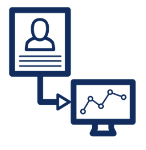Detecting Insurance Application Fraud in the Digital World
Detecting insurance application fraud in a digital-first environment is a challenge. Applicants lie about smoking, medical conditions, driving records, and more, and these simple misrepresentations can cost carriers millions.
Today, with machine learning, first-party intent data, and behavioral data science available to us, it’s not as hard as it used to be to identify fraudsters before they cause real harm.
Key Takeaways
- What is detectable non-disclosure?
- When and why do applicants lie?
- How to detect non-disclosure and application fraud
- The impacts of fraud on insurance companies
What is Detectable Non-Disclosure?
Misrepresentation in insurance stems from three main types: innocent, negligent, and fraudulent misrepresentation. Here are a few examples of fraudulent misrepresentation that can be detected on an application with the right software.
Smoker’s amnesia — A tongue-in-cheek way to say tobacco usage non-disclosure as a form of insurance application fraud. Research from Verisk reveals that 13.7% of the United States’ adult population are addicted to tobacco products, but up to an estimated 47% of life insurance applicants won’t tell the truth on an application. Smoker’s amnesia costs insurers $3.4 billion in estimated total premium loss per year.
Omitting pre-existing conditions. Another form of soft fraud, omitting pre-existing conditions, is as straightforward as it sounds. Common examples of these hidden conditions are HIV, high cholesterol, heart disease, and/or obesity. Applicants lie about these pre-existing conditions for fear of not receiving coverage or getting a higher premium agreement than their condition would warrant.
Fronting. The most common form of soft fraud in auto insurance is when a higher-risk driver (usually younger) is not listed as the main driver. Instead, a lower risk driver is the policyholder to get the lower premium. It’s hard to catch without tracking devices installed inside the vehicle and leads to more frequent and costly claims. The cost for auto insurers? $10.3 billion annually.
Incorrect income reporting. This often looks one of two ways. First — individual applicants will forge lower pay stubs or withhold proof of other income for lower sliding scale premiums. Or, less commonly, employers misrepresent their payroll to pay lower premiums regarding workers’ compensation.
When and Why Do Applicants Lie?
An insurance marketplace survey from CoverHound concluded that while men and women are equally likely to commit nondisclosure, millennials are more likely to attempt this than the generations before. Their research findings didn’t offer reasons why, but we can infer that millennials’ tech proficiency plays a role. So let’s call it what it is — if a user knows how to “cheat” the system and has motivations to do so (i.e., seeking a lower premium), they will.
Innocent and negligent misrepresentations are harder to detect on online applicants because the cues can be harder to trace; company transparency and user-friendly applications play a significant role in preventing these losses. Fraudulent misrepresentation, however, can be detected by predicting an online user’s intent.
In the section above, we uncovered how much each kind of non-disclosure can cost insurers, but what does this cost insurers in total? Not including health insurance fraud, the most recent FBI report estimates the annual cost of fraud to be $40 billion per year. It’s expensive for both insurers and their customers. The average American family pays an extra $400-$700 per year from increased premiums. The loss to insurers really depends on the size of the company.
Detecting Non-Disclosure and Insurance Application Fraud
Providing a seamless user experience without sacrificing risk and fraud is a heightened challenge as all platforms continue to migrate online. Behind the ‘faceless’ internet screen, what can insurers do to detect non-disclosure and insurance application fraud? First, we need to take a step back and understand what the industry used to rely on.
What Did Agents Use to Rely On?
This might come as a shock, but insurance applications used to be done on real paper, processed by a human.
I know, know… Times were different before the internet. As recently as five years ago, an agent might sit down with a potential customer and read traditional body language to assess authenticity.
For instance, if the customer was confident and straightforward with answers, the agent could sense a higher level of trust (and lower level of risk.) But if they were displaying nervous behavioral cues, the agent would note a potential red flag and would initiate a more thorough questioning. (Check out our article on digital body language to dive deeper into this.)
Insurance application fraud has been around since day one, so this approach wasn’t bulletproof, but it’s what insurers had to work with.
What can agents and underwriters do now that everything is done online?
Imagine sitting down with a customer to fill out an application, but before they begin, you put on a blindfold and noise-canceling headphones and then spin your chair around. That’s what detecting insurance application fraud online is like today without predictive analytics and real-time risk assessment.
For underwriters, it’s the same challenge, only doubled because they never interact with the customer. They have a few options now that everything is done online. First, they can reject the advancement and press forward (rather painfully) with manual processing. Or, they can succumb to the blindfolded method, move their system online with no supplemental software, and hope their fraud reports remain manageable — fingers crossed.
But the best and more obvious option is to offer accelerated underwriting with intent data software geared for accurate risk analysis. But you can’t make real-time decisions without real-time data, which is why you need software like ForMotiv that can do it for you.
For instance, underwriters can offer automatic, straight-through-underwriting for applicants who displayed high-intent behavior. Or, they can receive a flagged application whose user displayed high-risk behavior.
The Impacts of Fraud and Non-Disclosure on Insurance Companies
ForMotiv helps several Top 25 carriers identify misrepresentation and detect insurance application fraud. Take one of our partnering Fortune 500 insurance companies as an example. Like most insurers, they were looking to add additional datasets to their fraud, pricing, and underwriting models.
Before implementing behavioral intelligence and AI into their procedure, this insurer estimated that 17% of their policies were misrepresented. They were essentially blind to customer behavior during their online applications.
After implementing ForMotiv, they improved their risk models accuracy by 10%. That accuracy is expected to continue improving over time. (To read more about this Case Study with ForMotiv, head here.)
This insurance company is just one example of many that we’ve helped combat the challenge of identifying risk and application fraud.
Looking for the right risk analytics tool to predict insurance application fraud? Look no further. At ForMotiv, we understand that a balance needs to be struck between a seamless user experience and a well-protected application.
Schedule a call to see how we can improve your risk analytics.





